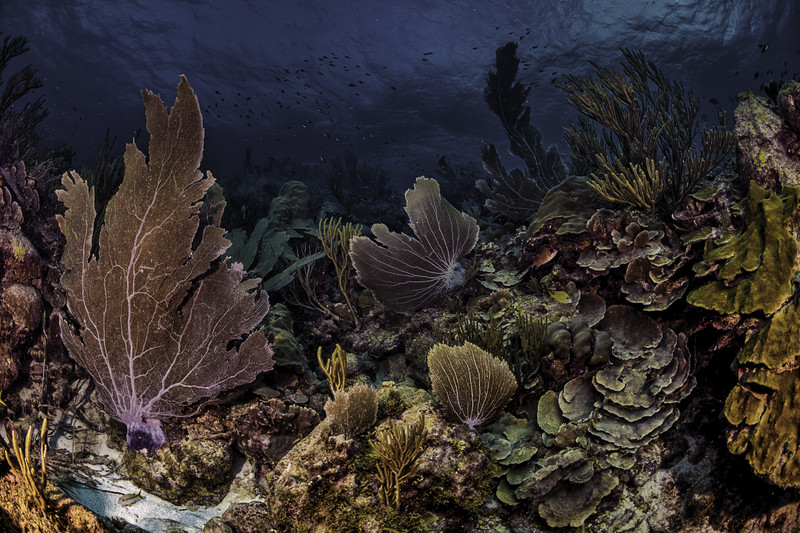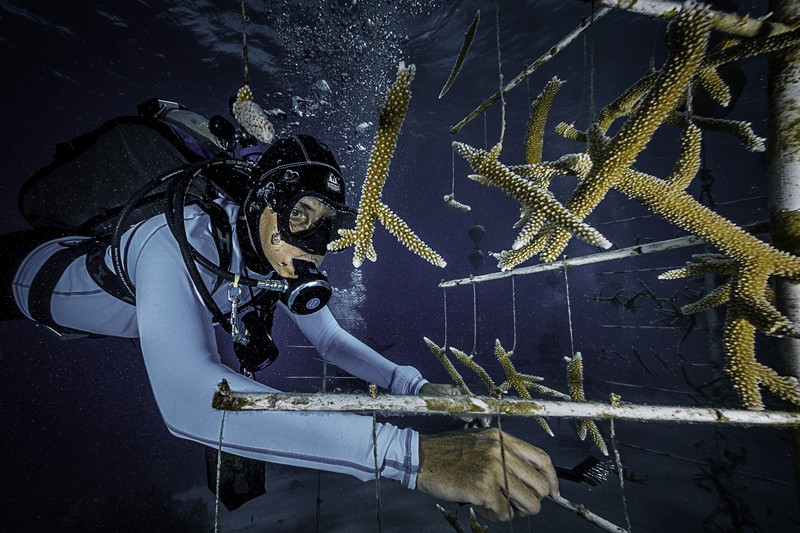Reef Renewal
© Lorenzo MittigaThe ocean is vast but it is vulnerable. We have explored not even the 5% of the ocean's world, yet we've destroyed systematically the 90% of the species in it. Caribbean reef have declined since the 70's from 50% of live corals to 8%. As a solution, an action is taken from the Reef Renewal Foundation Bonaire. Thousands of corals are produced through fragmentation techniques in nurseries on Bonaire and strategically outplanted later to local degraded reefs promoting genetic diversity. The RRFB protects and restores coral reefs by developing new and innovative ways to restore reefs that are supported by research collaborations and shared worldwide; by training, engaging, and inspiring the community locally and internationally through volunteering, educational events, and outreach; by demonstrating that through community efforts there is still hope for coral reefs.
The Foundation currently takes care of 8 nurseries with over 115 trees in total. Each tree typically holds about 100 corals. Five years of successful results has to be as a great example to follow from other similar realities.
Conservation International considers the waters around Bonaire to be a hotspot of Caribbean biodiversity, anyway, in the leeward coast of the island, some sites are exposed to the dust coming from the coastal costructions and the corals are progressively suffocated by it. The particles of dust infact are falling on the reef line and, once in the water, are falling as rain on the corals.
Pristine coral garden at the windward coast of Bonaire. The atlantic side of the small caribbean island of Bonaire is well known as the East coast. Beaten by costant strong winds and heavy underwater currents, with practically zero human impact, the reef ecosystem of this coast is still intact. Where nature makes it difficult for us to reach it, its sceneries are amazingly superb.
Mission and History of Reef Renewal Foundation
The ocean is vast but it is vulnerable. We have explored not even the 5% of the ocean's world, yet we've destroyed systematically the 90% of the species in it. Caribbean reef have declined since the 70's from 50% of live corals to 8%. As a solution, an action is taken from the Reef Renewal Foundation Bonaire. Thousands of corals are produced through fragmentation techniques in nurseries on Bonaire and strategically outplanted later to local degraded reefs promoting genetic diversity. The RRFB protects and restores coral reefs by developing new and innovative ways to restore reefs that are supported by research collaborations and shared worldwide; by training, engaging, and inspiring the community locally and internationally through volunteering, educational events, and outreach; by demonstrating that through community efforts there is still hope for coral reefs.
The Foundation currently takes care of 8 nurseries with over 115 trees in total. Each tree typically holds about 100 corals. Five years of successful results has to be as a great example to follow from other similar realities.
Conservation International considers the waters around Bonaire to be a hotspot of Caribbean biodiversity, anyway, in the leeward coast of the island, some sites are exposed to the dust coming from the coastal costructions and the corals are progressively suffocated by it. The particles of dust infact are falling on the reef line and, once in the water, are falling as rain on the corals.
Pristine coral garden at the windward coast of Bonaire. The atlantic side of the small caribbean island of Bonaire is well known as the East coast. Beaten by costant strong winds and heavy underwater currents, with practically zero human impact, the reef ecosystem of this coast is still intact. Where nature makes it difficult for us to reach it, its sceneries are amazingly superb.








RRFB History
Reef Renewal Foundation Bonaire (formerly Coral Restoration Foundation Bonaire) is a non-profit organization founded in 2012, when Ken Nedimyer, Founder of Coral Restoration Foundation, was invited to visit the island to work with and assist Bonaire with their continued efforts to preserve Bonaire’s greatest assets, its coral reefs.In February 2012, the Bonaire government together with the Bonaire National Marine Park, granted a permit to a local dive operator to start a reef restoration pilot project. The project centered on the restoration of the shallow reefs by establishing staghorn and elkhorn coral nurseries and restoration sites and still does today. The project started with just a few corals in one nursery on Bonaire and has grown each year every since. Today, over 13,000 corals are grown in RRFB eight nurseries and over 22,000 corals have been outplanted back to Bonaire’s reefs.
RRFB The Mission
The Mission of Reef Renewal Foundation Bonaire is to protect and restore coral reefs in Bonaire by developing new and innovative ways to restore reefs that are supported by research collaborations and shared worldwide. By training, engaging, and inspiring the community locally and internationally through volunteering, educational events, and outreach. By demonstrating that through community efforts there is still hope for coral reefs.
Every one can Get Involved as volunteer and become a Reef Renewal Diver.
The “Adopt A Coral” program is designed to provide a tangible way to engage in Reef Renewal Foundation Bonaire’s restoration efforts. When adopting through the program, you are directly funding the restoration of Bonaire’s reefs.
Thousands of corals are produced through fragmentation techniques in nurseries on Bonaire and strategically outplanted later to local degraded reefs promoting genetic diversity.
Coral Propagation
At Reef Renewal Foundation Bonaire, the current method of propagation begins with Coral Tree Nurseries. These nurseries are rows of PVC and fiberglass “trees” that are tethered to the bottom with sand anchors and buoyed with floats that sit just below the surface. This design allows the trees to move freely within the water column and dissipates wave energy, preventing damage both to the tree structure and the corals. Generally, each tree holds a unique genetic strain, or genotype, of coral, and a “full” tree can hold anywhere from 100 to 160 corals.
One of the primary benefits of coral nurseries is the care that can be provided to growing corals. Husbandry activities and maintenance of nursery sites are critical to maximizing coral health and minimizing incidence of disease, predation, and breakage.
The Coral Tree nursery has proved to be an efficient and effective way to grow and propagate second, third, and future generations of corals through fragmentation. Fragmentation is a process that occurs naturally when corals reproduce asexually. When a large fish or wave breaks a branch off the coral, the branch will continue to grow into a new coral if the water conditions are favorable. We mimic this process in our nurseries by using pliers to cut smaller pieces from existing, large corals. Those fragments get hung back on the same
tree, creating more corals of the same genotype. In this way, the Coral Tree nurseries become a self-sustaining approach to grow corals.
Currently we maintain 6 different permanent nurseries around the island. Combined they are comprised of over 100 trees and can hold over 13,000 corals. It is thanks to the support of the dive shop members, volunteers, and donors that RRFB have been able to maintain our nurseries and increase their capacity.
Outplanting
After six to eight months of growing in the nursery, the corals are healthy and mature enoughto beoutplantedto a restoration site.Coraloutplantingmeans moving nursery reared corals to a restoration site. Restoration sites are reef sites that are degraded and damaged and would benefit from the healthy corals growing there.
We take corals from the nursery and outplant them in restoration sites using various methods. The current methods include attaching corals to bamboo structures, adhering corals to solid substrate using a marine epoxy, and placing corals strategically in areas where conditions seem favorable. Whichever method we use, we tag the corals to keep track of the genetic information and to allow for short and long-term monitoring.
There are many criteria for selecting a restoration site. A few we take into consideration are existing and historical wild populations, depth, water quality, bottom type, size of the area, predator abundance, wave exposure, and the effects of human activities. These site characteristics also play an important role in helping to determine which outplanting method we use and how many corals get placed at that site.
Maintenance and Monitoring
Both coral nurseries and restoration sites are monitored regularly. We check our nurseries for disease, predation, damage to nursery structures, and more, which helps us control and prevent issues before they occur. The nurseries also receive regular cleaning in order to prevent the overgrowth of algae and fire coral. At restoration sites, we monitor survival rates, tissue paling, disease, and predation, among other aspects. The process of monitoring and maintenance gives corals another chance at success as we ensure that the coral fragments are in the position to mature and prepare for outplanting and our outplanted corals will continue to grow on their new substrate. Without reattachment, the broken fragments would most likely be unable to attach to the reef substrate on their own and would not survive.
A subset of outplanted corals is also monitored at set intervals after outplanting to better understand the short and long-term success of those corals. This is achieved by taking a mosaic, a series of photos of a monitoring site and stitching them together to create one big picture of the site. Mosaics are taken annually to help represent the corals change over time. With this data, we can better understand the factors affecting the success of our outplanted corals at different restoration sites.
In addition to the data-collecting monitoring activities, Reef Renewal Foundation Bonaire is also involved in documenting our corals in another way. Project Baseline is an initiative that aims to monitor the change of our oceans through time. RRFB regularly updates its database and collaborates with this effort by photographing outplanted corals over time to show the change happening at our restoration sites.
click to view the complete set of images in the archive
